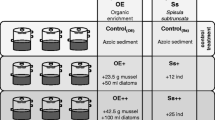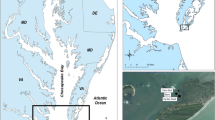Abstract
Potential nitrification rates (PNR) directly associated with isolated marine macrobenthic invertebrates were measured for a range of benthic epifaunal and infaunal species (bivalves, gastropods, polychaetes and crustaceans) collected from the Sacca di Goro, Po River delta, Italy. In the case of the filter-feeding bivalves, Tapes philippinarum and Mytilus galloprovicialis the PNR associated with the shell surfaces and dissected animal tissues (gills, siphons and residual tissue) were determined separately, in order to assess the distribution of the nitrifier populations. Significant PNR was found associated with all the tested macrofaunal species with activities ranging between 12 and 2,250 nmol ind.−1 day−1 and specific activities between 150 and 18,400 nmol g−1 dry weight day−1. However, no simple relationships were observed between PNR and the animals’ taxonomic or functional group, or with animal comportment (infaunal or epifaunal) or size class, indicating that more complex interactions may regulate the degree of colonisation of the animals by nitrifier populations. Incubations of shells alone and dissected tissues of the bivalves T. philippinarum and M. galloprovicialis demonstrated that approximately 50% of the total PNR activity was associated with the shell surfaces and 50% with the internal animal tissues, with the highest specific activities of 950 and 1,970 nmol g−1 dry weight day−1 determined for the gills of T. philippinarum and M. galloprovicialis, respectively. Thus, specific relationships may exist between the nitrifiers and their animal hosts. Overall, our data indicate that the macrofaunal stimulation of nitrification and/or coupled nitrification–denitrification observed in previous studies may not be solely due to the animals’ burrow walls serving as sites for nitrification, but also to the fact that the internal and external surfaces of the animals themselves are also colonised by nitrifying bacteria. Tentative calculations based on reported animal densities in the Sacca di Goro and the determined PNRs indicate that animal-associated nitrifier populations could contribute significantly to overall nitrification rates in situ, although further experiments are required to determine to what extent the potential rates measured in this study are realised under in situ conditions.



Similar content being viewed by others
References
Aller RC, Yingst JY, Ullman WJ (1983) Comparative biogeochemistry of water in intertidal Onuphis (Polychaeta) and Upogebia (Crustacea) burrows: temporal patterns and causes. J Mar Res 41:571–604
Bartoli M, Nizzoli D, Viaroli P, Turolla E, Castadelli G, Fano EA, Rossi R (2001) Impact of Tapes philippinarum farming on nutrient dynamics and benthic respiration in the Sacca di Goro. Hydrobiologia 455:203–212
Belser LW, Mays EL (1980) Specific inhibition of nitrite oxidation by chlorate and its use in assessing nitrification in soils and sediments. Appl Environ Microbiol 39:505–510
Blackburn TH, Henriksen K (1983) Nitrogen cycling in different types of sediments from Danish waters. Limnol Oceanogr 28:477–493
Bock E, Koops HP, Ahlers B, Harms H (1992) Oxidation of inorganic nitrogen compounds. In: Balows A, Trüper HG, Dworkin M, Harder W, Schleifer KH (eds) The prokaryotes. Springer, New York Heidelberg Berlin, pp 414–430
Dame RF, Dankers N (1988) Uptake and release of materials by a Wadden Sea mussel bed. J Exp Mar Biol Ecol 118:207–216
Davey JT (1994) The architecture of the burrow of Neries diverscolor and its quantification in relation to sediment–water exchange. J Exp Mar Biol Ecol 179:115–129
Denis L, Alliot E, Grzebyk D (1999) Clearance rate responses of Mediterranean mussels, Mytilus galloprovincialis, to variations in the flow, water temperature, food quality and quantity. Aquat Living Resour 12:279–288
Fenchel T (1996) Worm burrows and oxic microniches in marine sediments. 1. Spatial and temporal scales. Mar Biol 127:289–295
Florek RJ, Rowe GT (1983) Oxygen consumption and dissolved inorganic nutrient production in marine coastal and shelf sediments of the Middle Atlantic Bight. Int Rev Gesamten Hydrobiol 68:73–112
Forster S, Graf G (1992) Continuously measured changes in redox potential influenced by oxygen penetrating from burrows of Callianassa subterranea. Hydrobiologia 235/236:527–532
Gardner WS, Briones EE, Cruz Kaegi E, Rowe GT (1993) Ammonium excretion by benthic invertebrates and sediment–water nitrogen flux in the Gulf of Mexico near the Mississippi River outflow. Estuaries 16:799–808
Gray JS, Wu RS, Or YY (2002) Effects of hypoxia and organic enrichment on the coastal marine environment. Mar Ecol Prog Ser 238:249–279
Hansen K, King GM, Kristensen E (1996) Impact of the soft-shell clam Mya arenaria on sulfate reduction in an intertidal sediment. Aquat Microb Ecol 10:181–194
Henriksen K, Kemp WM (1988) Nitrification in estuarine and coastal marine sediments. In: Blackburn TH, Sorensen J (eds) Nitrogen cycling in coastal marine environments. Wiley, New York, pp 207–249
Henriksen K, Hansen JI, Blackburn TH (1980) The influence of benthic infauna on exchanges of inorganic nitrogen between sediment and water. Ophelia Suppl 1:249–256
Henriksen K, Hansen JI, Blackburn TH (1981) Rates of nitrification, distribution of nitrifying bacteria and nitrate fluxes in different types of sediment from Danish waters. Mar Biol 61:299–304
Henriksen K, Rasmussen MB, Jensen A (1983) Effect of bioturbation on microbial nitrogen transformations in the sediment and fluxes of ammonium and nitrate to the overlying water. Ecol Bull 35:193–205
Henriksen K, Blackburn TH, Lomstein BA, McRoy CP (1993) Rates of nitrification, distribution of nitrifying bacteria and inorganic N fluxes in northern Bering-Chukchi shelf sediments. Cont Shelf Res 13:629–651
Herbert RA (1999) Nitrogen cycling in coastal marine ecosystems. FEMS Microbiol Rev 23:563–590
Hylleberg J, Henriksen K (1980) The central role of bioturbation in sediment mineralization and element re-cycling. Ophelia Suppl 1:1–16
Kaplan WA (1983) Nitrification. In: Carpenter EJ, Capone DG (eds) Nitrogen in the marine environment. Academic, New York, pp 139–190
Kristensen E (1984) Effect of natural concentrations on nutrient exchange between a polychaete burrow in estuarine sediment and the overlying water. J Exp Mar Biol Ecol 75:171–190
Kristensen E, Jensen MH, Andersen TK (1985) The impact of polychaete (Nereis virens Sars) burrows on nitrification and nitrate reduction in estuarine sediments. J Exp Mar Biol Ecol 85:75–91
Kristensen E, Jensen MH, Aller RC (1991) Direct measurement of dissolved inorganic nitrogen exchange and denitrification in individual polychaete (Nereis virens) burrows. J Mar Res 49:355–377
Magni P, Montani S, Takada C, Tsutsumi H (2000) Temporal scaling and relevance of bivalve nutrient excretion on a tidal flat of the Seto Inland Sea, Japan. Mar Ecol Prog Ser 198:139–155
Mayer MS, Schaffner L, Kemp WM (1995) Nitrification potentials of benthic macrofaunal tubes and burrow walls: effects of sediment NH4 + and animal irrigation. Mar Ecol Prog Ser 121:157–169
Nakamura M, Yamamuro M, Ishikawa M, Nishimura H (1988) Role of the bivalve Corbicula japonica in the nitrogen cycle in a mesohaline lagoon. Mar Biol 99:369–374
Nizzoli D, Castadelli G, Bartoli M, Welsh DT, Arriaga Gomez P, Fano EA, Viaroli P (2002) Benthic fluxes of dissolved inorganic nitrogen in a coastal lagoon of the northern Adriatic Sea: an interpretation of spatial variability based on sediment features and infaunal activity. Mar Ecol 23:297–306
Pelegrί SP, Blackburn TH (1995) Effect of bioturbation by Neries sp., Mya arenaria and Cerastoderma sp. on nitrification and denitrification in estuarine sediments. Ophelia 42:289–299
Pelegrί SP, Nielsen LP, Blackburn TH (1994) Denitrification in estuarine sediment stimulated by the irrigation activity of the amphipod Corophium volutator. Mar Ecol Prog Ser 105:285–290
Prins TC, Smaal AC (1994) The role of the blue mussel Mytilus edulis in the cycling of nutrients in Oosterschelde estuary (the Netherlands). Hydrobiologia 282/283:413–429
Riisgaard HU, Larsen PS (2000) Comparitive ecophysiology of active zoobenthic filter feeding, essence of current knowledge. J Sea Res 44:169–193
Rysgaard S, Christensen PB, Nielsen LP (1995) Seasonal variation in nitrification and denitrification in estuarine sediment colonized by benthic microalgae and bioturbating infauna. Mar Ecol Prog Ser 126:111–121
Sayama M, Kurihara Y (1983) Relationship between burrowing activity of the polychaetous annelid, Neanthes japonica (Izuka) and nitrification–denitrification processes in the sediments. J Exp Mar Biol Ecol 72:233–241
Seitzinger SP (1988) Denitrification in freshwater and coastal marine environments: ecological and geochemical significance. Limnol Oceanogr 33:702–724
Smaal AC, Zurburg W (1997) The uptake and release of suspended and dissolved material by oysters and mussels in Marennes-Oléron Bay. Aquat Living Resour 10:23–30
Smorczewski WT, Schmidt EL (1991) Numbers, activities and diversity of autotrophic ammonia-oxidizing bacteria in a freshwater, eutrophic lake sediment. Can J Microbiol 37:828–833
Stanier RY, Adelberg EA, Ingraham JL (1984) General microbiology, 4th edn. Macmillan, London
Strickland JDH, Parsons TR (1972) A practical handbook of seawater analysis, 2nd edn. Bull Fish Res Board Can 67
Acknowledgements
I. Zucconelli is gratefully thanked for his assistance with the incubations and analysis of samples. E. Turolla and D. Viviani are thanked for their help in collecting the animals used in this study and their knowledge of the Sacca di Goro and where the individual species occur.
Author information
Authors and Affiliations
Corresponding author
Additional information
Communicated by R. Cattaneo-Vietti, Genova
Rights and permissions
About this article
Cite this article
Welsh, D.T., Castadelli, G. Bacterial nitrification activity directly associated with isolated benthic marine animals. Marine Biology 144, 1029–1037 (2004). https://doi.org/10.1007/s00227-003-1252-z
Received:
Accepted:
Published:
Issue Date:
DOI: https://doi.org/10.1007/s00227-003-1252-z




